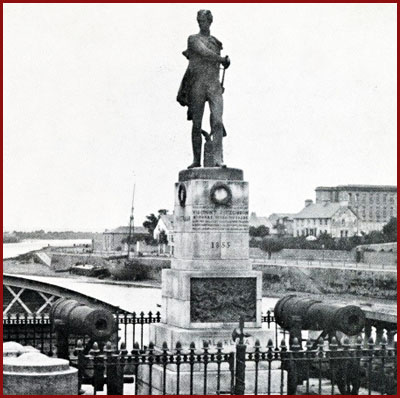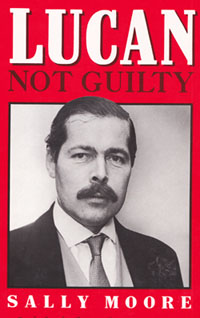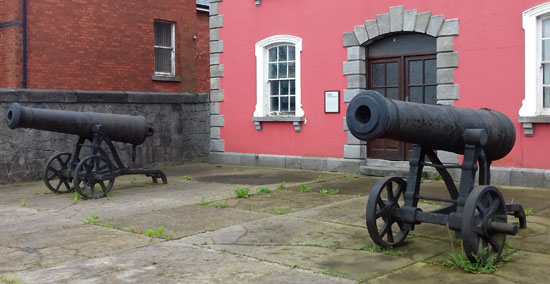|

 CRIMEAN CANNONS - WHERE ARE THEY NOW?
CRIMEAN CANNONS - WHERE ARE THEY NOW?
Harbour Commissioners Office
next door to Steamboat Quay
Limerick
Limerick City
Ireland
V94 H6HN
The two Limerick Crimean cannons once stood on Sarsfield Bridge either side of the Fitzgibbon memorial. (see picture right) Unfortunately the memorial was blown up, supposedly by the 'old' IRA. This is the site where now stands a later 1916 memorial. The Sarsfield Bridge was originally known as Wellesley Bridge. It was designed by Alexander Nimmo. Although the foundation stone was laid on 15 October 1824 the bridge was not officially opened until August 1835. The contractors were Clements & Sons.

The two Crimean cannons, now relocated at the Harbour Commissioners premises, are a memorial to the involvement of the Limerick people in the war with Russia. One particularly intriguing story comes to light concerning John, son of the 3rd Earl of Clare. Titled Lieutenant Viscount Fitzgibbon of Mountshannon House (near Castleconnell) Limerick, he supposedly fell during the Crimean conflict and was the subject of a memorial statue on the Sarsfield Bridge. At the age of twenty five Viscount Fitzgibbon was reported as missing presumed dead at the Charge of the Light Brigade in 1854.
Although it has never been verified, during the second Afghan War, twenty five years after the Charge of the Light Brigade, the Eighth Hussars (Viscount Fitzgibbon's regiment) were stationed in India near the North West frontier. One night a dishevelled looking man who spoke English, but seemed unaccustomed to doing so, was brought
into the Officers' mess. He was invited to stay for dinner where he surprised all by having an uncannily good knowledge of the regimental customs, thereby suggesting that he was a former officer of that regiment.  He was not asked to identify himself, but on examining the regimental records it was discovered that the only ex-officer of the Eighth Hussars whose whereabouts had not been positively accounted for, was Viscount Fitzgibbon. He is also reported to have turned up in London c.1870. He was not asked to identify himself, but on examining the regimental records it was discovered that the only ex-officer of the Eighth Hussars whose whereabouts had not been positively accounted for, was Viscount Fitzgibbon. He is also reported to have turned up in London c.1870.
Ironically, it was Lord Lucan (George Bingham), a great nephew of Sarsfield himself (one of the senior commanders of James VII & II in battles in Ireland with William of Orange) who gave the final order for the fateful cavalry charge at the massive battery of Russian artillery in 1854. The title's notoriety was renewed after the disappearance in 1974 of the 7th earl, Lord Lucan. This followed a police investigation into the murder of the children's nanny Sandra Rivett in London on the 7th November. He was never traced. Now there is a coincidence!
Right - Sally Moore's 1987 excellent book on the circumstances surrounding the 1974 disappearance of Lord Lucan.

Arguably the cannons have been technically surrendered on two occasions. The first time in 1855 by the Russians to the French & British armies in the Crimea and the second occasion by the British themselves to the Irish Free State in 1922.
Today the two Russian cannons captured during the Crimean War (1853-56) are on display outside the old Harbour Commissioners Office in the Ted Russell Dock. Robins records two 36 pdrs. Access is subject to dock regulations and security but the railings by the Clayton Hotel next door give a view of the guns.
ADDITIONAL INFORMATION

CONSTRAINTS
Not open to the public
LANDSCAPE
City Centre
REGION
Ireland
THE FEATURES PRESENT
Crimean Cannon Location, past or present
|









